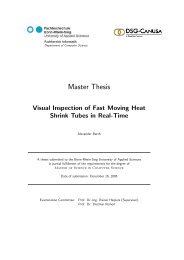Master Thesis - Hochschule Bonn-Rhein-Sieg
Master Thesis - Hochschule Bonn-Rhein-Sieg
Master Thesis - Hochschule Bonn-Rhein-Sieg
You also want an ePaper? Increase the reach of your titles
YUMPU automatically turns print PDFs into web optimized ePapers that Google loves.
4. Overall evading concept <strong>Master</strong> <strong>Thesis</strong> Björn Ostermann page 39 of 126<br />
Since the project was developed to run as a demonstrator, these images are also used to explain the<br />
camera’s function during demonstrations. The enhancement of both images is not tied to the<br />
functionality of the program but is only done with respect to a human observer.<br />
4.3.2 Background acquisition<br />
from<br />
part 1<br />
Acquire<br />
new<br />
background<br />
Acquire several<br />
distance data<br />
Compute median in<br />
each pixel<br />
Store as<br />
background<br />
variable<br />
4 5 6<br />
Load<br />
Background<br />
(from file)<br />
Acquire<br />
background<br />
data from Data<br />
Exchange<br />
Object<br />
Store as<br />
background<br />
variable<br />
Save<br />
Background<br />
(to file)<br />
Transmit<br />
background<br />
data to Data<br />
Exchange<br />
Object<br />
Figure 22: Camera control thread – part 2<br />
Recording, storing and retrieving the distance values of the workspace’s background<br />
The first subpart of the second part in Figure 22 (button 4) is the acquisition of the background of the<br />
workplace. This acquisition has to be activated, if the workplace has been altered, e.g. if a new static<br />
object was included in the workplace. During this acquisition the workplace has to be free of dynamic<br />
objects, which generally includes the robot. Since this is not possible with a robot fixed to the floor, a<br />
compensation algorithm has been programmed (see chapter 4.3.4) that later deals with the robot’s<br />
unmovable base.<br />
The distance data of the camera contain fluctuation noise, caused by inaccuracy in the distance<br />
measurement of the 3D camera. The manufacturer specifies an error of 1% of the measured distance in<br />
the camera’s manual [55]. Thus, to achieve reliable data from the environment, several distance data<br />
samples are taken (500) to compensate for the camera’s error. The median value in each pixel is<br />
computed (see chapter 5.2.1.1) during this measurement process. The resulting data is smoothened by<br />
a Gaussian function to further compensate errors in the measurement (see chapter 5.2.1.2). Upon<br />
completion of the background acquisition, the data is stored in memory.<br />
As long as there are no changes to the workplace, the background data remains the same. Therefore<br />
this data does not need to be reacquired with every program start, but can be loaded from a stored set<br />
of data. This saves time during the setup phase of the standard program start. Also the background<br />
part 3














